Consumer brands like Nike, Adidas, and Puma see major growth opportunities in the newfound elevation of streetwear. All of a sudden, they’re more than just sports apparel brands—they’re nods to high fashion, open doors to what’s cool.
These brands also know “sneakerheads”—people who are addicted to the chase for an exclusive item—will wait hours in front of a store for a limited edition product.
The coinciding rise of athleisure (a hybrid of gymwear and leisure clothing), and the celebrity influence on that stream of fashion, has further encouraged these consumer brands to lean into the fashion-meets-casual streetwear look. It’s contributing to a streetwear industry valued in excess of $187 billion.
Streetwear market definition and stats
Streetwear is a type of casual clothing heavily influenced by popular culture. It’s an eclectic mix of apparel from New York’s hip hop culture and California skateboarding fashion that became popular in the 1990s.
Today, streetwear dominates the social media scene. This has contributed to a global streetwear industry recently valued at $187.58 billion, accounting for about 10% of the global footwear and fashion industry.
Growth in the streetwear market shows no signs of slowing down. Experts predict the industry will hit a $193.21 billion valuation by 2027, with a compound annual growth rate (CAGR) of 3.52%.
Why? Because customers spend big bucks on streetwear:
44% of customers buy streetwear items at least once a month.
Consumers reported spending up to five times more per month on streetwear than non-streetwear.
Between $100 and $300 is the sweet spot for pricing streetwear items, with 56% of consumers spending that amount on a single item of streetwear.
Sneakers are the standout streetwear product with 62% of consumers selecting footwear as the item they were most likely to buy. Other popular streetwear pieces include oversized t-shirts, hoodies, and joggers.
What is the target market for streetwear?
Streetwear buyers tend to be Millennial or Gen Z and therefore have some disposable income. They’re typically working professionals who don’t have children or mortgages to worry about, and have lived most of their lives online.
A report by Hypebeast confirms this:
Three quarters of streetwear customers are aged 25 or under.
70% of streetwear customers report an annual income of $40,000 or less and spend between $100 and $500 per month on streetwear.
Almost a quarter of customers buy a streetwear item because it’s a status symbol.
Kristen Classi-Zummo, apparel industry analyst at NPD, told Vogue Busines that “Gen Z wants a bike short that they can wear to both the airport or to brunch, but they are also looking for it to keep them cool and stay in place.”

Customers spend big bucks on streetwear.
Thanks to the democratization of social media, everyone will know that a cool T-shirt is expensive or a pair of headphones costs $3,000. The rise of the tech sector and fewer traditional industries employing younger people has also meant smart, expressive and casual clothing is now more accepted in the workplace.
Social commerce platforms like TikTok and Instagram dominate the marketing strategies of many streetwear brands for this reason. The user base of either platform is a Gen Z consumer that’s grown up in a hyper-connected digital world where likes are a normalized currency.
Consumers, of course, care about looking cool and mirroring what celebrities are doing. But it shows they are keen to remain authentic to their own personality, and above all else, stay comfortable—which feels like the antithesis of fashion.
10 streetwear marketing ideas and strategies
Crowdsource inventory ideas
Sell the lifestyle, not the product
Build a community
Partner with streetwear creators
Collaborate with other brands
Blend online and offline retail channels
Experiment with the metaverse
Induce scarcity with product drops
Prioritize sustainability
Play on nostalgia
1. Crowdsource inventory ideas
With a quarter of consumers buying streetwear for social status, people rely on social media to tell them what’s hot and what’s not. Consumers—not brands—are driving trends in the space.
Listen in on these conversations with social listening tools like Mention or Google Trends. Spot a streetwear trend on the rise and configure a product that capitalizes on it, using pre-orders as a way to validate product ideas before you invest manufacturing resources.
2 Chainz takes this approach with its streetwear label. It doesn’t rely on its hip hop founder’s face or likeness to sell products. Charlie Jabaley, co-founder Street Execs, the management and marketing firm that helped 2 Chainz’s store coordinate inventory ideas, says, “You can’t just take an artist’s face, put it on a shirt, and expect people to buy it anymore.”
2 Chainz reverse-engineers the traditional merchandising process. It gauges interest to discover popular designs, iterates based on fan feedback, and manufactures only the most popular products guaranteed to sell. Its ecommerce site automatically scales to handle traffic demands associated with these product drops.
Charlie Jabaley, co-founder of Street Execs, said: “It’s just so simple and easy to work with Shopify Plus. We can quickly upload images of shirts we know are going to sell, easily process orders, and track inventory in real time.”
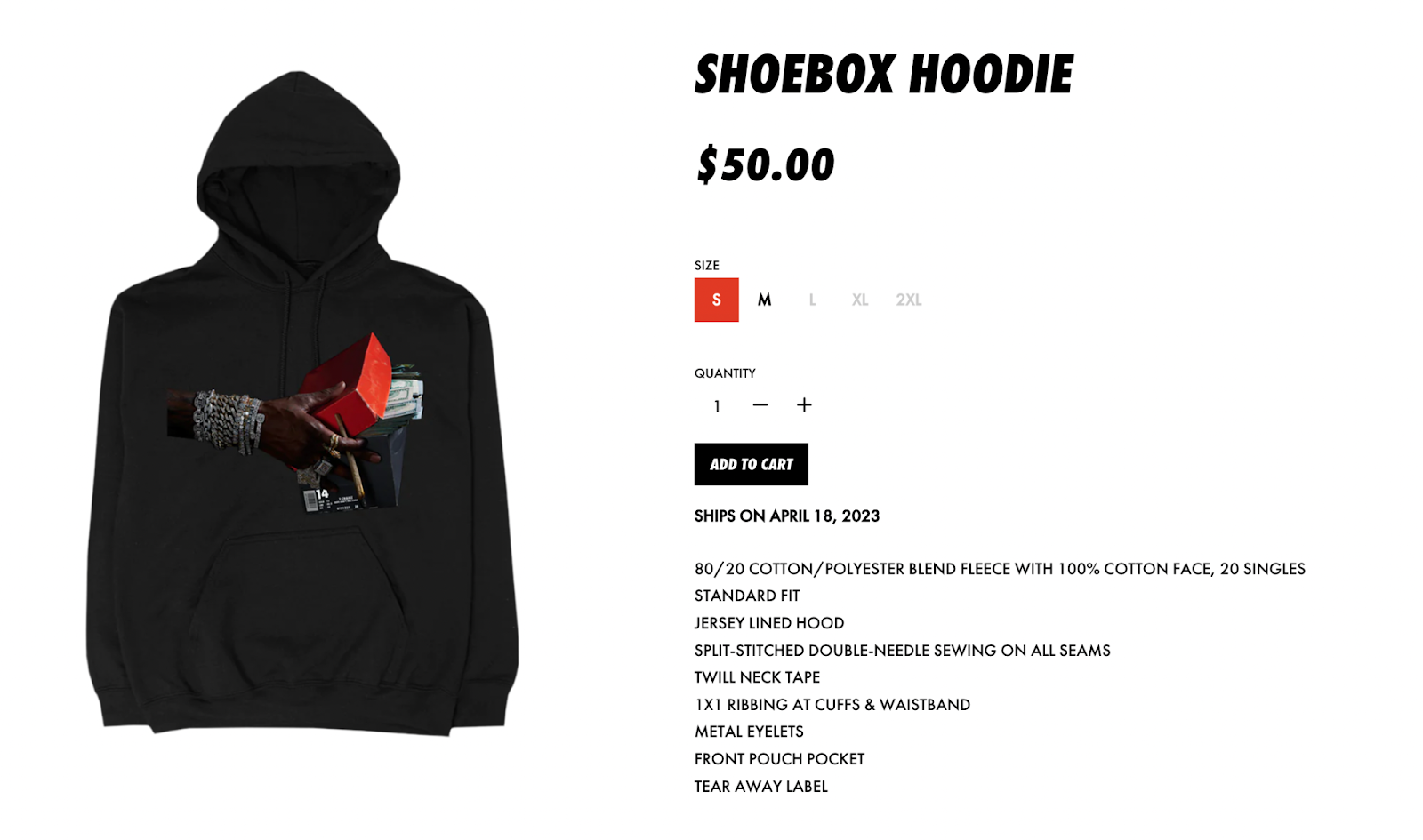
2 Chainz’ ecommerce store.
2. Sell the lifestyle, not the product
When you work inside a streetwear company, it’s easy to get caught up in the nitty gritty details of your product. After all, you’re proud of each item and they tend to sell out.
But streetwear customers don’t always buy individual items because of their impressive specifications. People buy them to fit into streetwear culture—a lifestyle movement where dressed-down, comfortable clothing is a social status.
Maniere De Voir is one streetwear brand which took this approach with a marketing campaign. Slotted between Instagram posts that showcase its products, it publishes short-form videos that sell the lifestyle its target audience are looking to create.
This Instagram Reel, for example, showcases a cozy, minimalist interior design—two adjectives that customers would use to describe the brand's image.
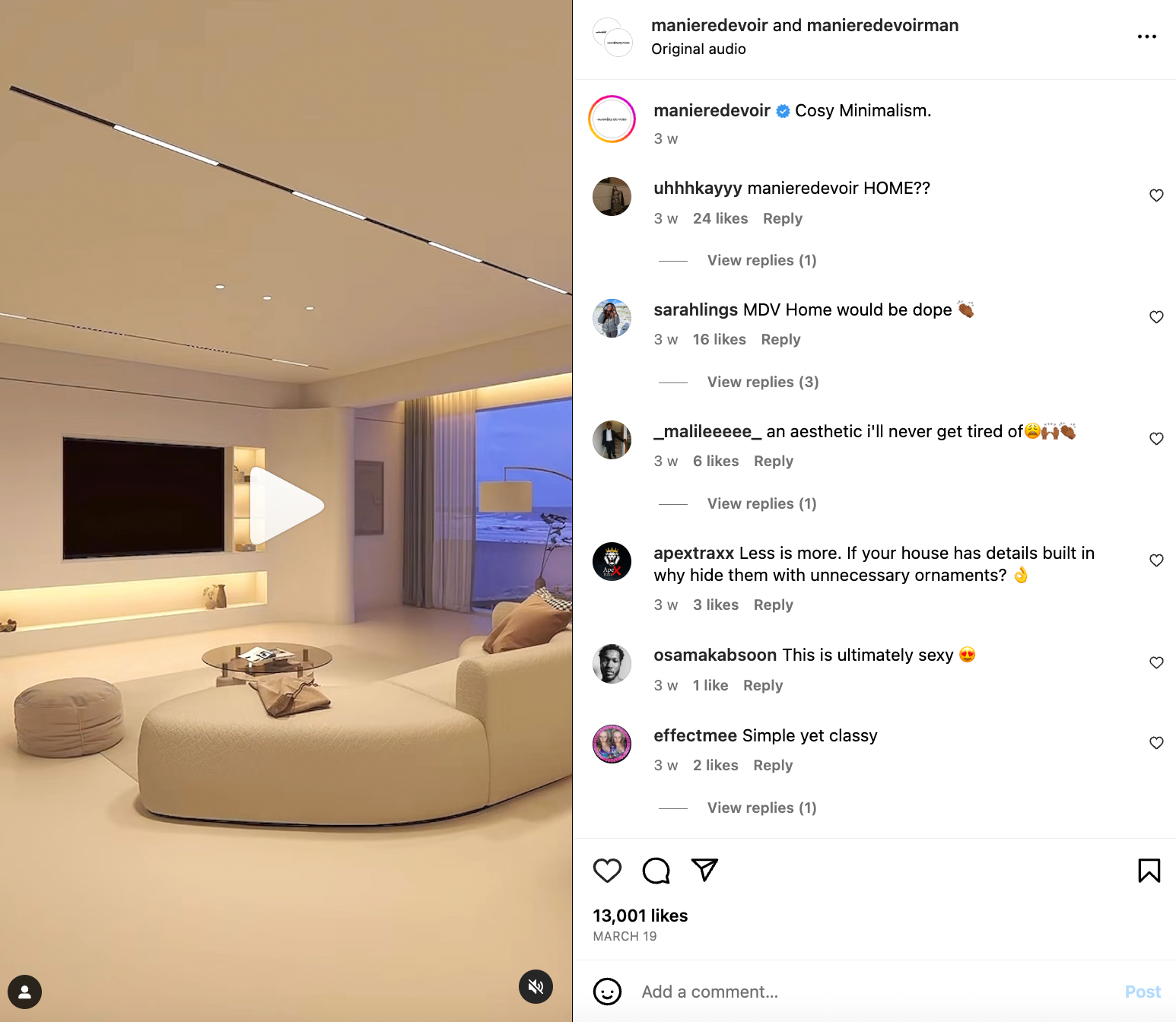
Maniere De Voir sells the lifestyle its customers desire.
Incorporate this into your streetwear brand marketing strategy by creating a broader identity around your clothing brand.
What words would customers use to describe your streetwear items? What does their dream life look like? Angle your marketing campaigns around the answers to sell the lifestyle they want to create using your apparel.
3. Build a community
The COVID-19 pandemic accelerated the growth of online communities and this community still drives commerce today.
Take the online fitness community that largely overlaps streetwear culture. McKinsey reports that 85% of consumers expect to continue using an online fitness and wellness program, as well as digital exercises.
Capitalize on this—and strengthen brand loyalty—with an online community. Whether it’s a Facebook group, a TikTok audience, or an in-store community, these consumer hubs build emotional attachment to your brand.
Tap into these communities when you’re:
Sourcing new product ideas
Collecting user-generated content (UGC) for marketing campaigns
Give loyal fans exclusive priority access to product drops
Streetwear brand Charlie Hustle is one retailer using the local community approach to drive consumer loyalty. Its slogan is “do good, feel good, look good”—a motto the brand uses to help its audience achieve with its Communi-TEES program.
Consumers in the Kansas City area can donate to local charities through any purchase it makes on the brand’s direct-to-consumer store.
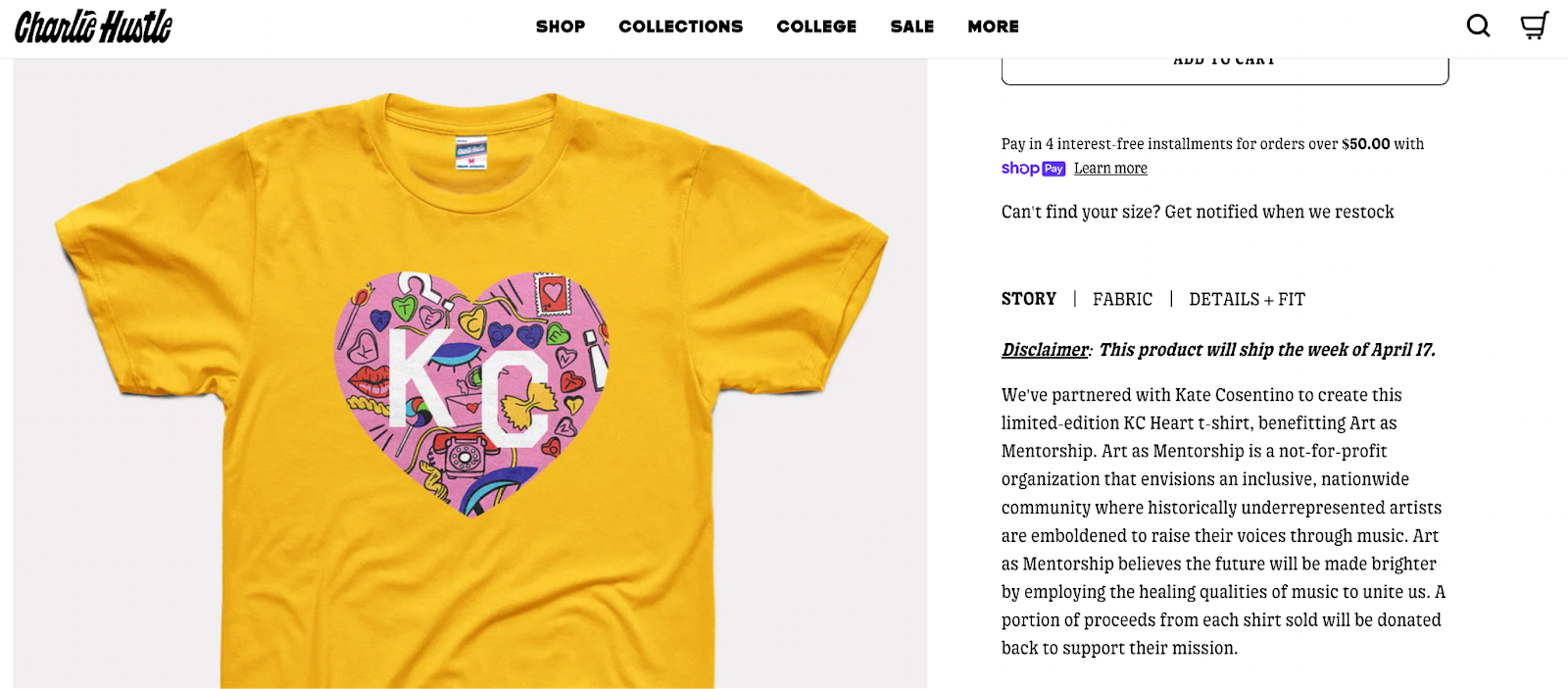
Customers who buy its T-shirt can donate to the Art as Mentorship non-profit.
4. Partner with streetwear creators
The digital-native Gen Z relies heavily on social media influence when determining which products to buy.
For the majority of streetwear customers, social media is the top source of inspiration. It beats the street, word of mouth, and fashion publications.
This makes sense—Gen Z’s purchasing habits are wildly different from older generations. Data compiled in the Future of Commerce report found almost 40% of Gen Z use TikTok and Instagram for search over Google, contributing to a social commerce industry set to reach $80 billion by 2025.
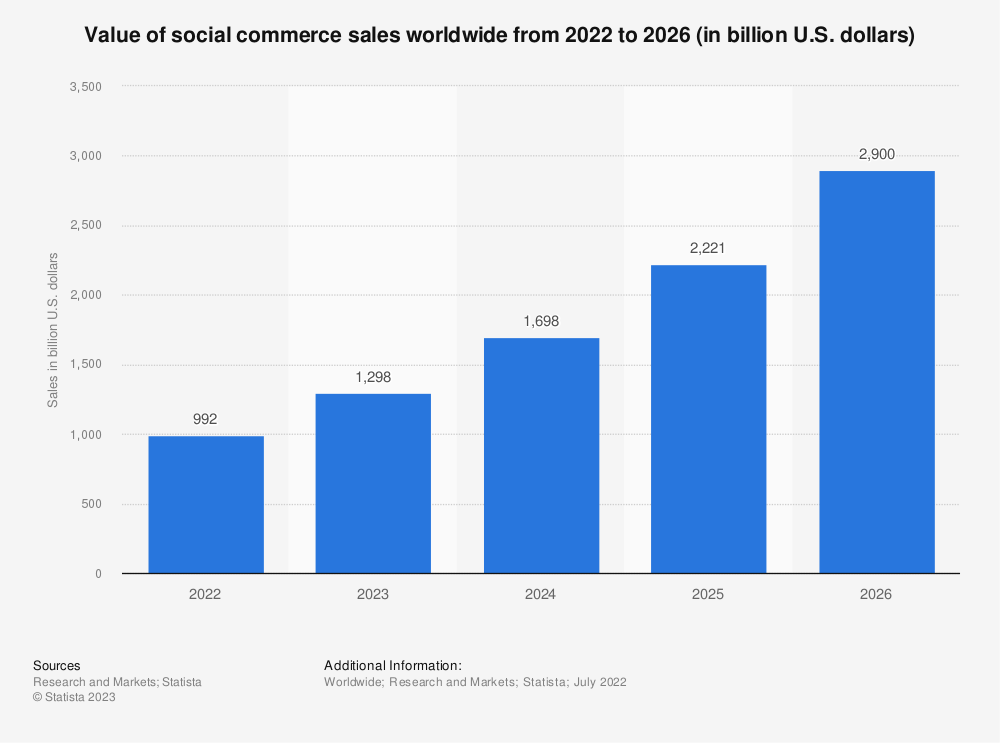
Social commerce is on the rise. Source: Statista.
But a simple social media marketing strategy isn’t enough. Although Hypebeast found most consumers use social media as a source of information, less than a third (31%) consider a brand’s own social media presence as an important factor.
Plus, with the emergence of platforms like TikTok enabling everyone to be a creator (up to 40% of people under 35 consider themselves to be one), fashion brands can tap into the social nature of streetwear while publishing the user-generated content its audience trusts.
Sportswear-turned-streetwear label Puma takes this to the extreme with its Dua Lipa partnership. The singer, known for her casual fashion sense, launched a limited edition collection with the brand. Both parties went back and forth on Instagram to strengthen the partnership and get both customer bases excited.
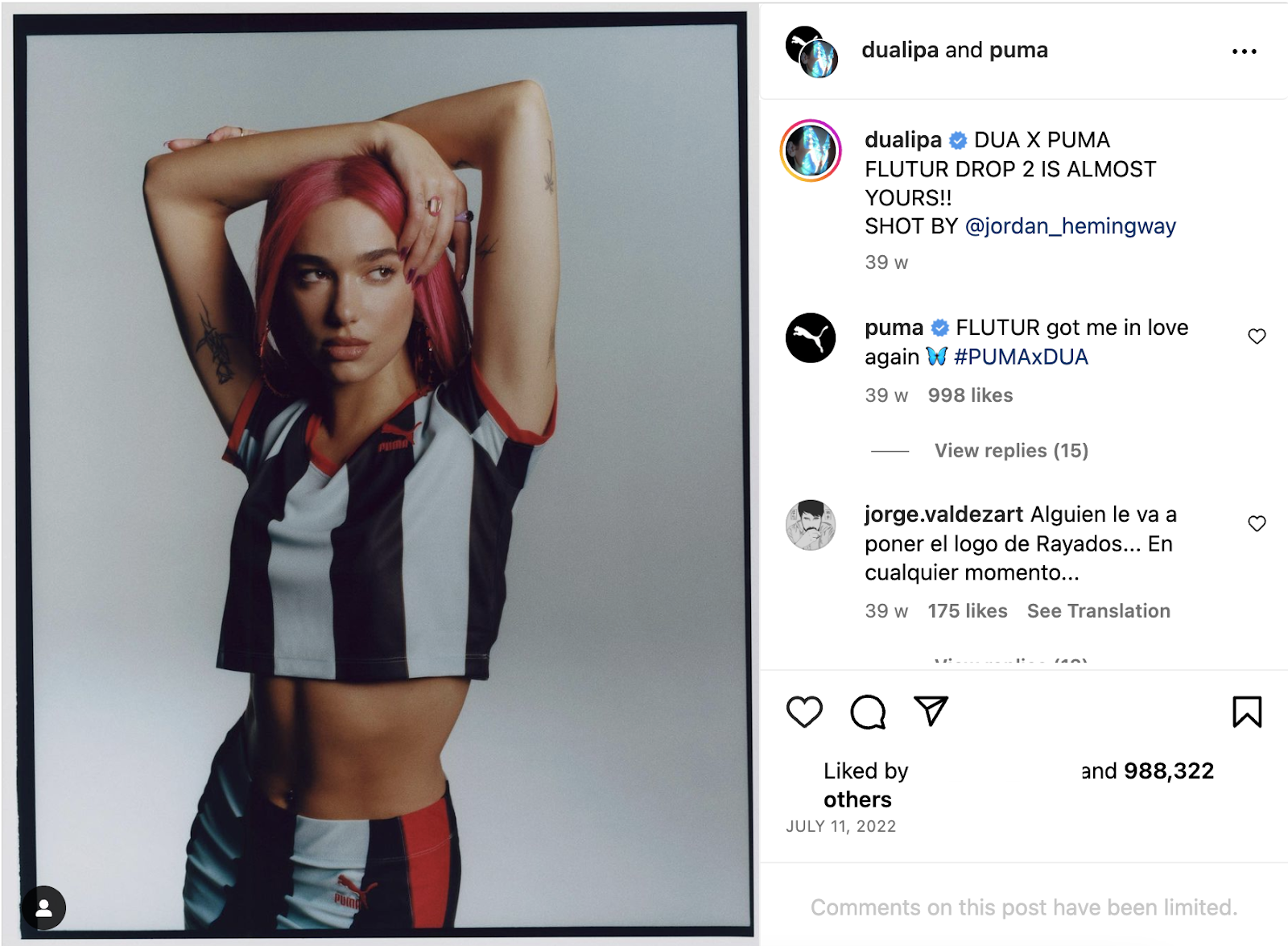
The Dua Lipa x Puma collaboration.
Shopify Collabs helps brands discover creators, influencers, and affiliates in the streetwear industry. Partner with these creators—be that through gifted products, sponsored posts, or affiliate commissions—to generate UGC through influencer marketing. This will show how your streetwear items look on real people.
5. Collaborate with other brands
Streetwear brands are leaning into co-marketing opportunities as a way to stand out in a saturated market.
Shopify’s Alex Danco says that "the biggest opportunity flying under the radar is collaboration. It’s the best way to increase the number of buyers who know and care about you in a way that turns you into not competitors but cooperators, perhaps even allies and friends.”
Identify brands that share your audience. The best collaborations are between two brands that share overlapping brand values and customer demographics without being direct competitors.
Alex adds: “Collaboration is truly the win-win way for brands to find new audiences in a way that doesn’t dilute your brands.”
Take Parks Project, for example. The streetwear retailer has a distinct unique selling proposition—streetwear items that draw inspiration from US national parks.
In a bid to tap into new audiences and create an element of exclusivity, Parks Project collaborated with different companies to produce limited edition products including:
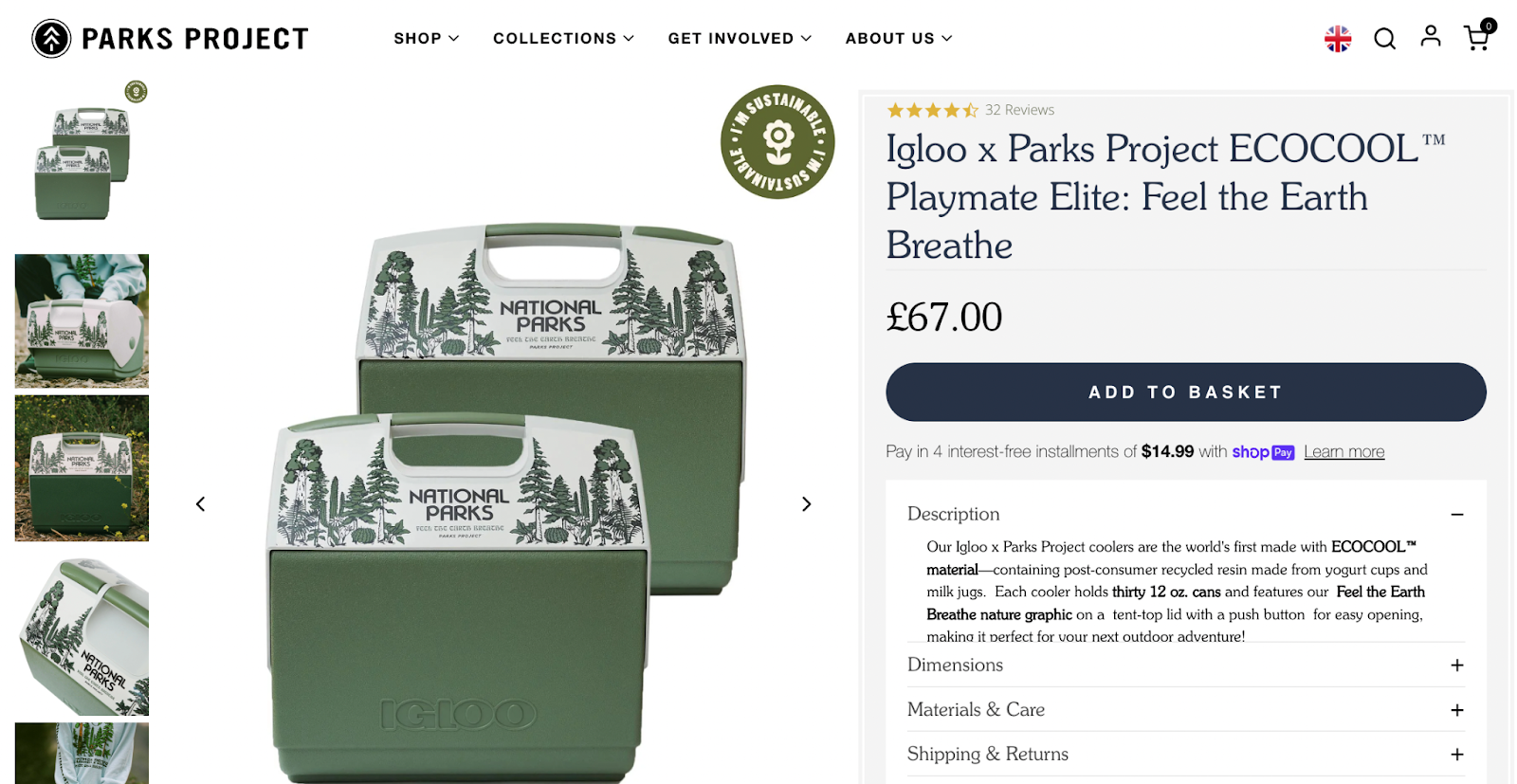
One of Parks Project’s many collaborations.
The sneakers element is a particularly interesting collaboration. Hypebeast reports that sneakers are the most popular streetwear product, but that this market is also one of the most saturated.
As Zofia Zwieglinska, international fashion reporter at Glossy, says, “Most brands dedicate a portion of their collection to streetwear, and sneakers in particular. Tie-ins to art and music have continued—from the Nike x RTFKT partnership with Takashi Murakami to Tiffany's tie-in with Basquiat and Beyonce.
“However, sneakers and streetwear have reached a saturation point–the differentiators now will be with brands that can evolve it to suit a new type of customer.”
6. Blend online and offline retail channels
Gen Z might use social media to research brands more often than search engines, but social media is driving in-store foot traffic (and subsequent sales) for many streetwear retailers.
More than half of customers said they’re most likely to buy streetwear items through a physical brand store, followed by 42% who head to the retailer’s ecommerce website—hence why 60% of retailers say flagship locations are a key part of their brand strategy.
British streetwear brand Corteiz has mastered this online-to-offline marketing strategy. Its social media presence drives in-person commerce with time-sensitive product drops at key locations in London.
This Instagram post, for example, encouraged followers to visit its market stall with 99p in exact change to buy its blackout cargo trousers. The stall was only open for two hours and co-ordinates for the location dropped just a few hours before the event began.
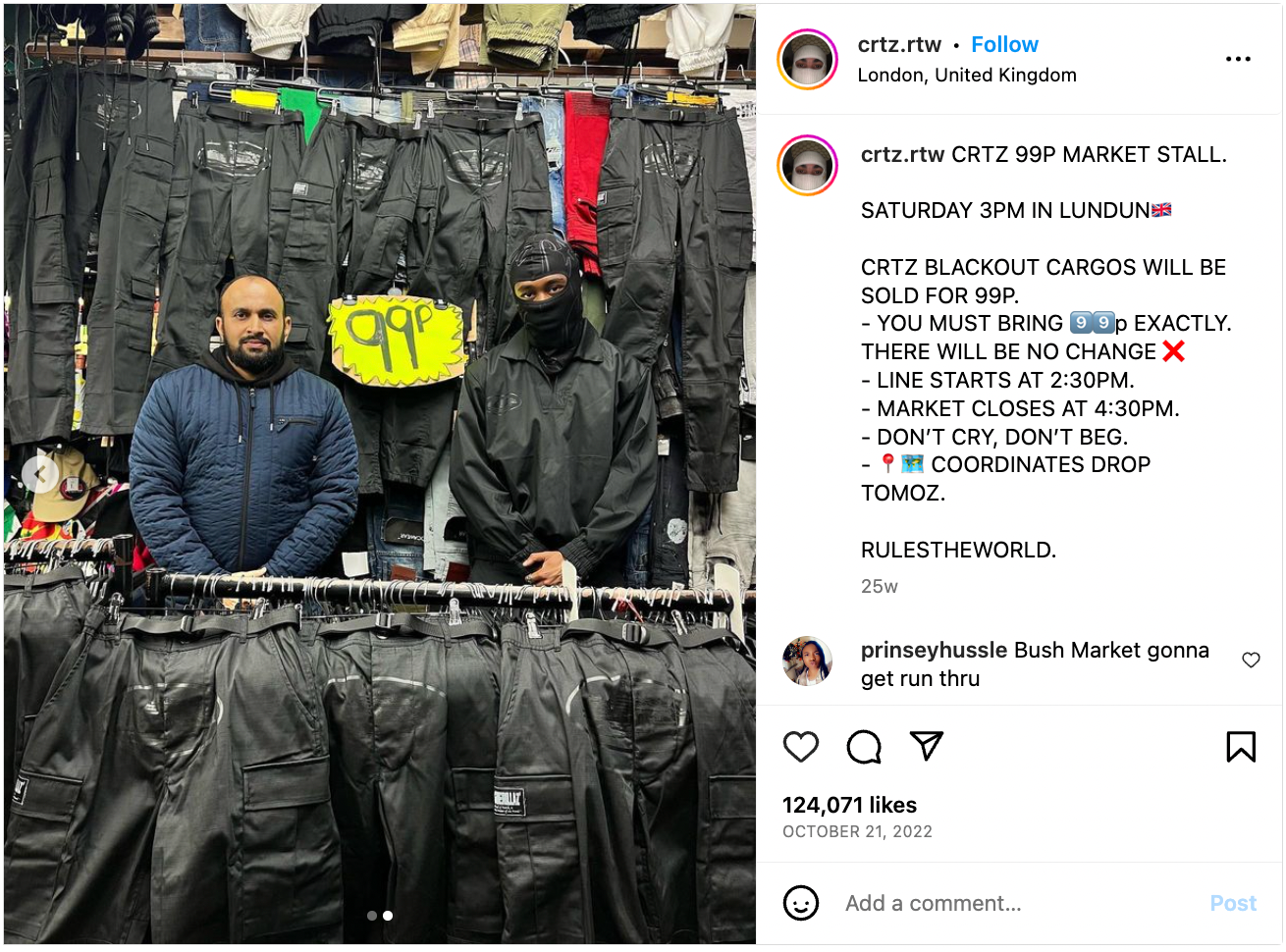
Corteiz promoted the drop of its 99p cargo pants through Instagram..
The viral nature of Corteiz’s in-person product drops helps build a base of die-hard fans who want in on the brand’s community. So much so, people document their attempts to locate Corteiz’s product drop locations on YouTube and TikTok—a streetwear brand marketing idea that gets customers to do the legwork of building hype around product drops.
Experiment with new markets and products quickly—without the overhead. Make sales wherever your customers are with Shopify POS and mobile card readers, so you can accept payments on the spot. Learn more.
7. Experiment with the metaverse
With customers craving experiences from the streetwear brands they interact with, the metaverse—a 3D virtual experience where customers can play, shop, and interact with other people—is quickly becoming a staple in many marketing strategies.
Data compiled in the Shopify Commerce Trends 2023 report found one in three shoppers already use virtual reality to shop, and by 2026, Gartner predicts that 25% of people will spend at least one hour per day in the metaverse.
This consumer habit is causing almost three-quarters of global business decision makers to conclude that interacting with customers in the metaverse will become commonplace.
German sneaker retailer Flowers For Society is one label centered heavily around metaverse experiences. Its first product drop, which was only available through pre-order, linked every item with a unique non-fungible token (NFT).
Customers gained access to the brand’s own metaverse community, unlocking exclusive access to future product drops, limited edition apparel, and exclusive collaborations.

Flowers for Society heavily pushes its metaverse experience on Instagram.
Sell NFTs on your streetwear store with Shopify Plus. Give customers exclusive access to products, collections, and discounts, and sync your store with community engagement channels like Discord—all in one place.
Induce scarcity with product drops
Exclusivity is an important element for streetwear fans.
Zofia says “Digital-native brands need to focus on how streetwear customers interpret value differently to their other customers. Aspects like rarity, collectability, and wider cultural value matter more to these customers, as well as engagement with the brand community.”
Two-thirds of streetwear brands surveyed by Hypebeast described the drop model as important to their business. It capitalizes on rarity, collectability, and cultural value by making streetwear products time- or quantity-limited.
Streetwear brand Live Fast Die Young uses the drops model to fuel its social media campaigns. On Instagram, the retailer regularly teases new product drops, such as its new 54-piece collection. Customers flock to its comment section to express their anticipation.
Maksim Telkov, ecommerce manager at Live Fast Die Young, added: “With our product drops, we always had problems with over ordering or that payments didn't go through. With Shopify Plus, these issues were resolved all at once.”
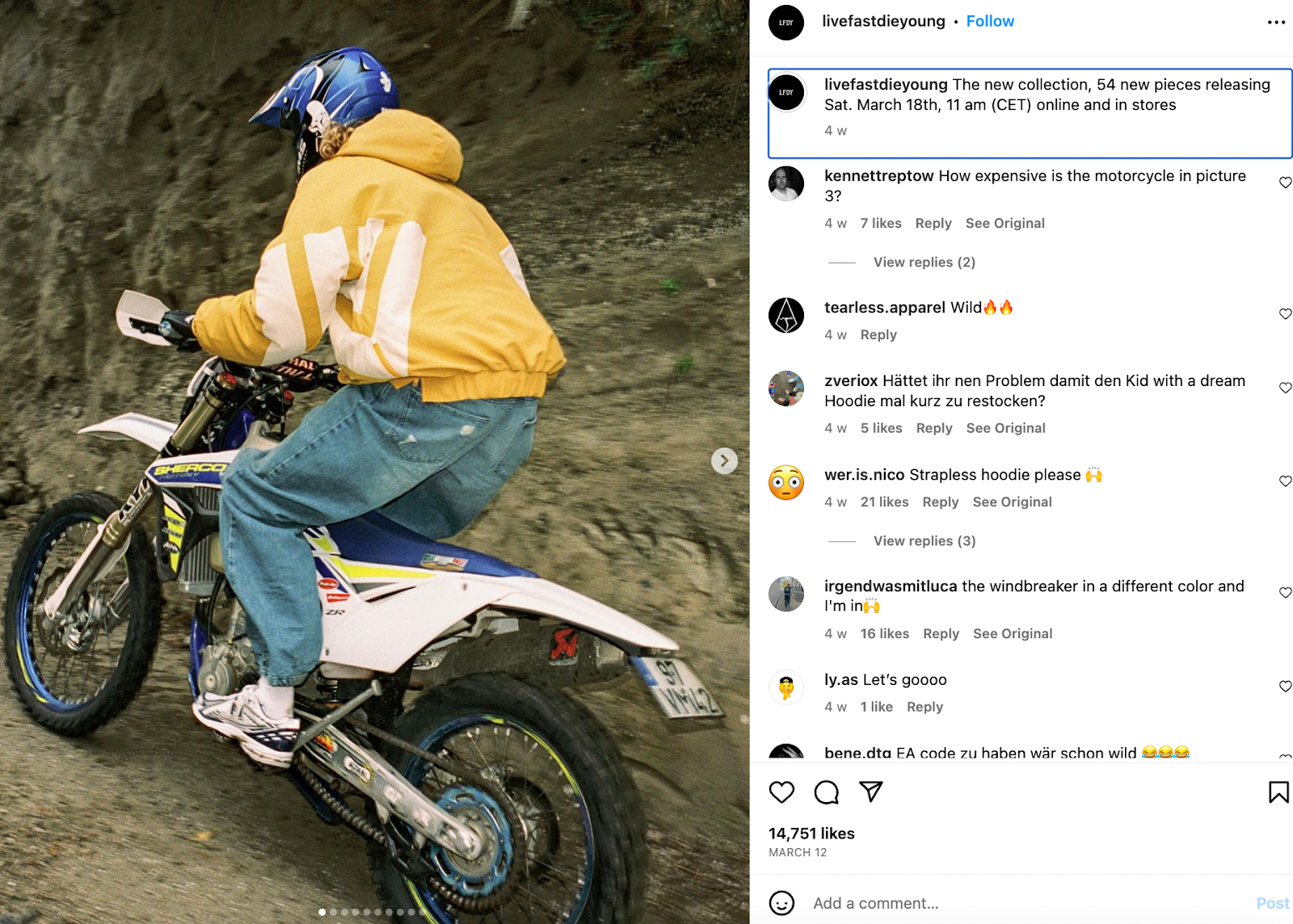
Live Fast Die Young promotes its product drops on social media.
Use Shopify Plus’ pre-ordering functionality to create product pages and capture leads before the product goes on sale. You’ll be able to take full, partial, or no payment from customers and set expectations on when the item will be delivered.
If they don’t buy this time, an automated email marketing series can convert subscribers into paying customers. Email your subscribers when the product drops—a surefire way to get their attention, rather than relying on a social media post which might get buried in a crowded feed.
8. Prioritize sustainability
Sustainability is more than a buzzword for modern consumers; McKinsey reports that two in three customers think sustainability is an important factor when buying apparel.
Customers have the same approach to sustainability when purchasing streetwear. The majority of consumers said social issues were important to them, with brand activism playing a role in the clothing brands consumers choose to connect with.
Co-founder Ryan Wood says that Coney Island Picnic prioritized sustainability in its mission to keep up with consumer preferences: “About a year ago, our brand made the conscious decision to shift the manufacturing of all tees and fleece to be sourced from organic cotton without raising the price for customers.”
This commitment to sustainability is deeply rooted across every aspect of the brand’s marketing strategy. Coney Island Picnic displays a “sustainable” category in its ecommerce navigation, produces short-form TikTok videos to explain its brand mission, and highlights how products are made using organic cotton within product descriptions.
Ryan Wood, co-founder and creative director of Coney Island Picnic, says: “As we know, the fast fashion industry's current trajectory will not sustain much longer, and many consumers want to avoid being a part of the wasteful cycle. Therefore, more consumers are taking note of sustainable retailers they can trust and becoming repeat customers.”
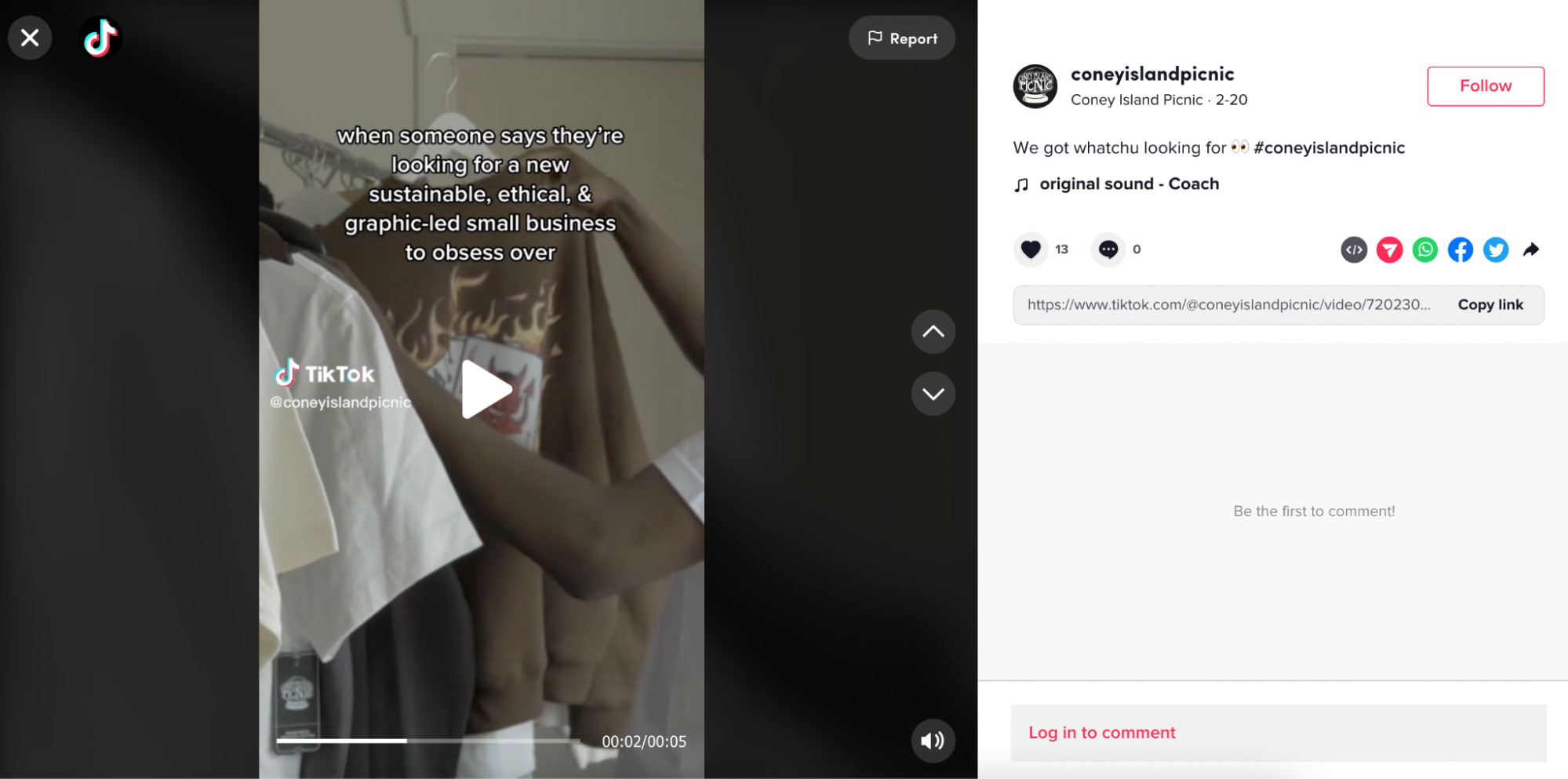
Coney Island Picnic’s TikTok strategy.
If you’re not in a position to make your products more sustainable, don’t try to pull the wool over your customers’ eyes. Greenwashing—the term people use to describe clothing brands that exaggerate their role in making their business more sustainable—doesn’t fly with Gen Z customers.
Studies have shown 88% of Gen Z consumers don’t trust brands’ environmental claims. However, you can make small changes to prove your streetwear brand is moving in the right direction without overhauling your entire logistics strategy or supply chain.
The Shopify Planet app, for example, makes a small contribution to the Shopify Sustainability Fund. This fund is used to pull carbon dioxide out of the atmosphere and make shipping carbon neutral.
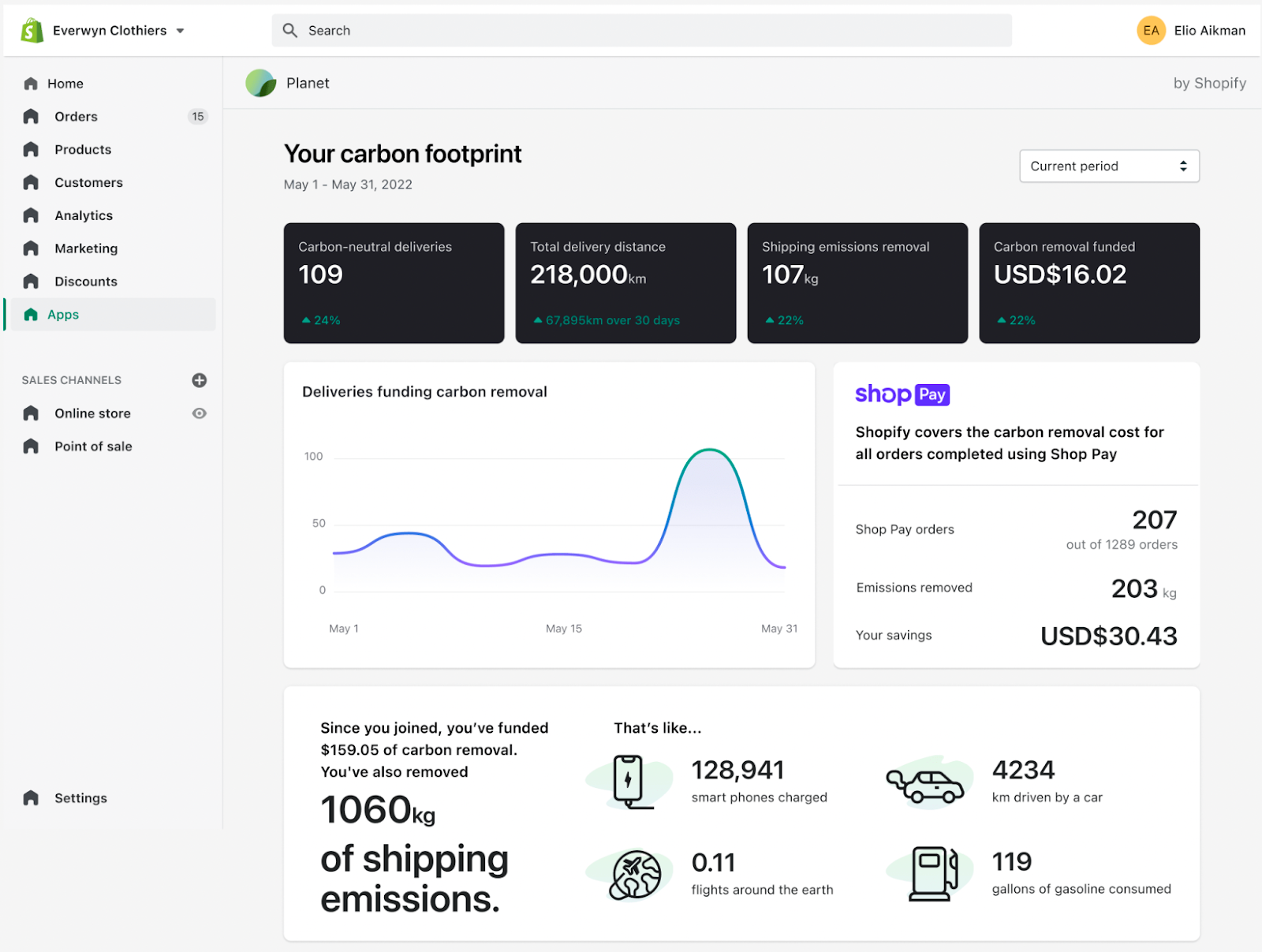
Offer carbon-neutral shipping with Planet.
9. Play on nostalgia
Gen Z has had to thrive in difficult economic conditions. They report higher rates of anxiety, depression, and distress than any other demographic, often turning to nostalgia as a temporary escape from normal life.
Business Insider reports the nostalgia trend is being driven by this generation. In the article, Krystine Batcho, professor and psychologist at Le Moyne College, says, “For many people, particularly young adults or those without a financial safety net, poor economic conditions raise fears of being able to meet financial obligations like rent or student-debt payments.”
As a result, Google searches for “Y2K outfits”—an abbreviation for the year 2000—have increased by 9600% over the last five years. Related hashtags like #nostalgia and #Y2K are both thriving on TikTok, having each amassed billions of views.
Streetwear brands are tapping into this nostalgia to connect with Gen Z consumers. Streetwear Society, for example, launched an apparel collection that reflected the Y2K aesthetic.

Streetwear Society’s product descriptions reference the Y2K trend.
The collection page—and products that fall within it—are optimized for people searching for terms like “men’s Y2K streetwear” and “Y2K aesthetic clothes”.

Search appearance for Streetwear Society, optimized for “Y2K aesthetic clothes”.
Streetwear marketing examples
Supreme
New York-based brand Supreme is highly regarded for its influence on streetwear culture. What started as a Manhattan skateboarding store turned into a business acquired for $2.1 billion by VF, the parent company of VANS.
For 78% of consumers, the brand represents streetwear more than any other. Its community is Supreme’s biggest lever into acquiring and retaining customers.
Every new product is associated with a time-sensitive drop only available at one of its 11 retail stores. But you need an invite to get there, and a one purchase per person limit applies. Only customers on Supreme’s mailing list get the “golden ticket”—an invitation to join the hundreds of people that queue around the block to get their hands on a Supreme drop. And if they want more than one piece, they’ll need to bring a friend.

Queue of customers outside Supreme and Burberry’s London stores after its collaborative product drop. Source: Vogue Business.
A Bathing Ape (BAPE)
The founder of iconic streetwear brand A Bathing Ape (BAPE), Japanese artist Nigo, intentionally made a limited amount of merchandise when he started out in the early 1990s because he knew the desire for exclusivity would help his brand grow.
HighSnobiety reports that “Nigo started out on a tight budget and could only afford to produce around 50 T-shirts a week—but he also disliked the idea of everyone wearing the same thing.”
Alongside its drop model, BAPE got celebrities to wear its products to build hype and create the social symbol many streetwear customers aspire to. Hip hop stars like The Notorious B.I.G and Pharrell sported BAPE products, with Soulja Boy even rapping the words “I got me some Bathing Ape” in his 3x Platinum-hit Crank That.
Culture Kings
Australian streetwear retailer Culture Kings is known for its shopping experience. Instead of allowing shoppers to passively browse items, its stores are a true community experience.
The non-shopping activities on offer include:
A DJ
A basketball court
An in-store barbershop
The “Vault”—a section selling its rare and most exclusive streetwear products
Celebrity appearances from athletes, musicians, and celebrities who vouch for the brand

Local landing pages for Culture Kings’ stores detail the celebrities that have attended.
Culture Kings turned to Shopify Plus with a goal to mimic these in-store experiences for global shoppers online. It customized its storefront to display tailored, dynamic product listings with a Shop the Look page. Anyone viewing the brand’s social media content could easily shop the latest products through this landing page.
Simon Beard, co-founder of Culture Kings, said: “Shopify Plus—what it really did is allow us to more focus on our art side rather than being so bogged down in the science side, which was not our forte. It really enabled us to scale, knowing that we had this platform that delivered, that can grow with us.”
Off-White
Off-White differentiates itself from other streetwear players by bridging the gap between luxury brands and pop culture. Its founder, the late Virgil Abloh and former artistic director of Louis Vuitton, started the company in 2012 under the original name Pyrex Vision.
According to Front Office Sports, Off-White came to life as a result of Abloh’s 3% approach—the idea that a new design could be created with just a 3% difference.
Part of this differentiation includes irony—a sense of humor Gen Z consumers can bond over. Many of Off-White’s streetwear products obviously state the use case in quotation marks, like this windbreaker coat with the word “water” splashed across the back.
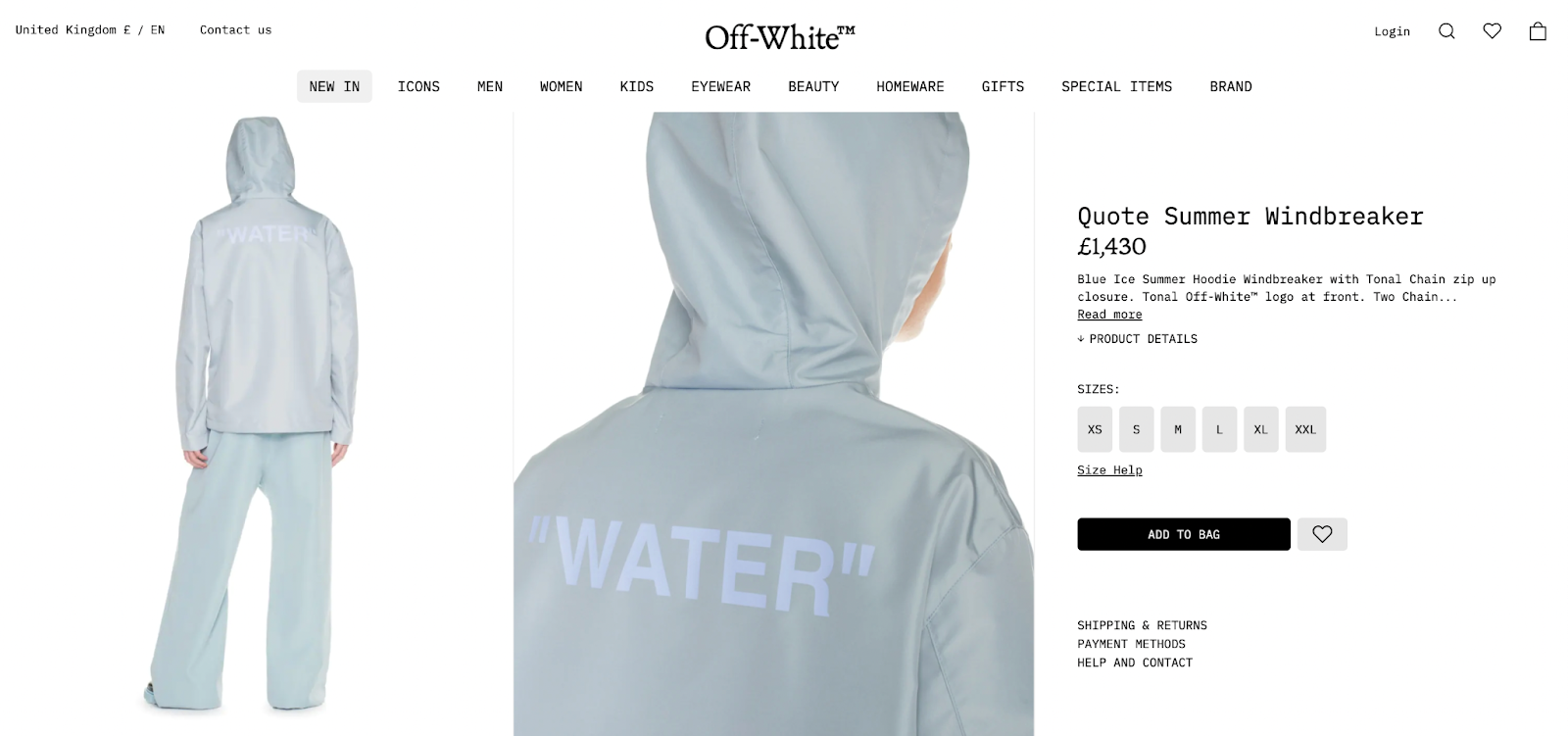
Product listing for Off-White’s windbreaker.
Princess Polly
Princess Polly, an established streetwear company located in Australia, took a unique approach with its marketing strategy. Alongside making itself a staple in their Gen Z customers’ shopping routine, the streetwear brand wanted to deliver a seamless experience long after the first purchase.
Alexandria Collis, director of operations at Princess Polly, says, "We're always looking for ways to create less pressure points for customers. Making returns difficult shouldn't be the goal—there's actually a real opportunity to create loyalty through the return experience."
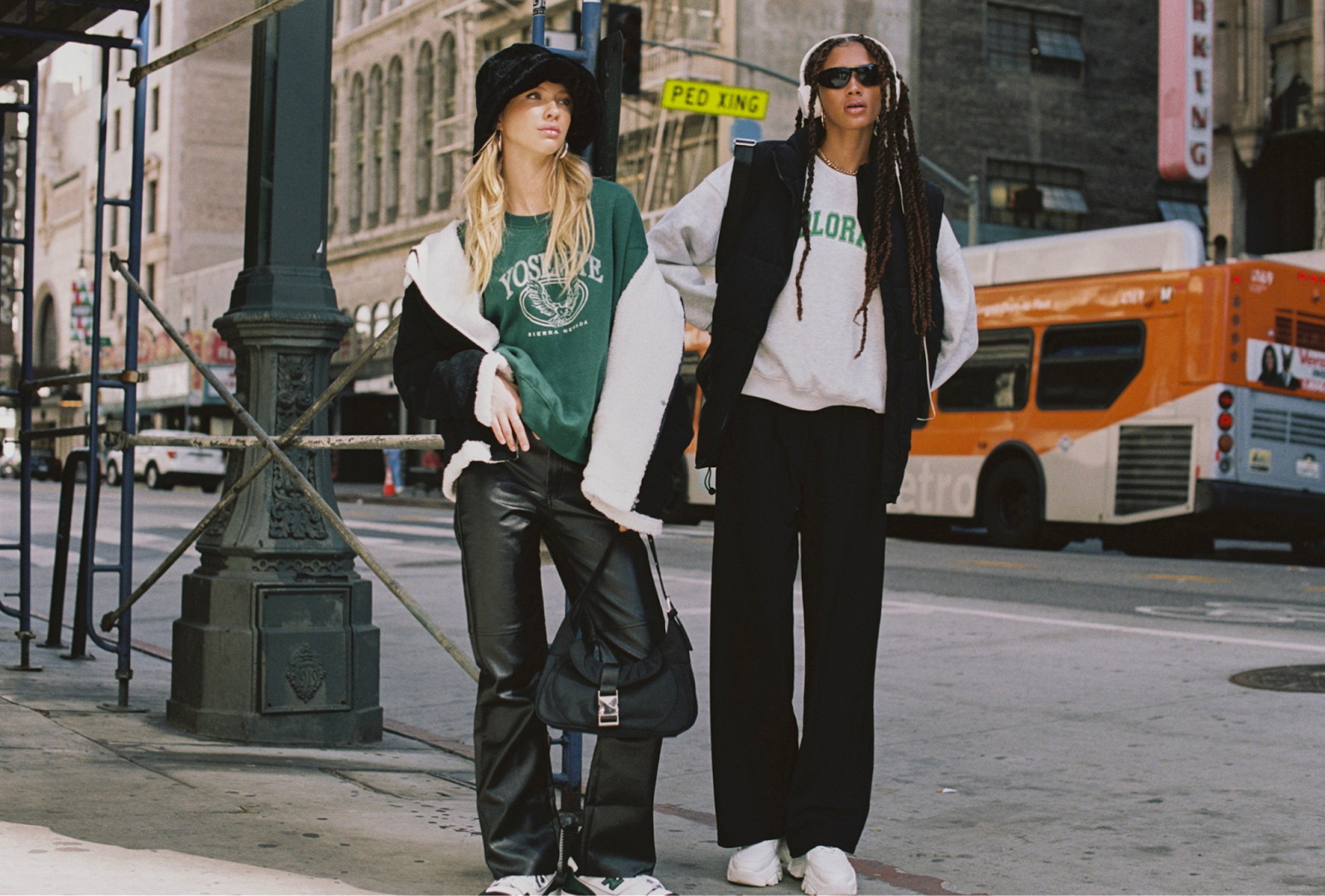
Princess Polly’s streetwear style.
The first stage was Princess Polly’s migration from Magento to Shopify Plus. It then enlisted the help of Shopify Plus Technology Partner Loop to access measurable returns insights and allow customers to exchange items, rather than request a refund.
The result? Princess Polly saw a 55% reduction in out-of-stock rates with its new instant exchange function.
Alexandria Collis, director of operations at Princess Polly, added: "Thanks to Shopify Plus and Loop, we’ve seen a huge improvement in our return experience, with customers telling us first-hand that they appreciate how easy it is. And not only is it improving our customer loyalty—it's also driving a significant uptick in revenue."
Capture the attention of streetwear customers with this marketing strategy
Streetwear is a competitive branch of the fashion industry. Brands who stand out don’t just sell products—they create communities around their products, selling the complete lifestyle and status symbol.
Use these streetwear marketing strategies to meet customers where they are. From inducing scarcity with product drops to experimenting with the metaverse, do it all with Shopify Plus’ all-in-one ecommerce platform for scaling stores.
What does the future of commerce look like? Download our 2023 Trends report and stay ahead of the curve.
Streetwear marketing FAQ
How do I promote my streetwear?
Launch limited product drops
Document the production process on TikTok
Prove your commitment to sustainability
Blend online and offline experiences
Collaborate with streetwear creators
What size is the current streetwear market?
The global streetwear market, previously estimated at $187.58 billion in 2021, is now projected to reach a valuation of $193.21 billion by 2027.
How can a streetwear brand stand out?
Partner with content creators
Sell the lifestyle, not the product
Prove sustainability claims
Play on nostalgia
Use experiential retail to connect with consumers
Who buys the most streetwear?
Gen Z are the biggest buyers of streetwear and account for 70% of all streetwear customers. These young people are typically working professionals who are active on social media and have disposable income to spend on streetwear.
Read more
- 4 Brands Rethinking Black Friday Cyber Monday Retail Strategies
- People Need A Reason To Shop: Retail Leaders on What Drives Consumers
- What You can Learn from the Multibillion Dollar Success of Singles Day
- Ultimate Flash Sale Ecommerce Guide: How to Sell Over $3 Billion on Autopilot
- What are the retail trends for 2023?
- The 30 Questions You Should Ask Before Selling Direct to Consumer
- Readership for Revenue: How 8 Publishers are Diversifying with DTC Ecommerce
- Shopify Migration | Transfer Your Store or Website to Shopify





